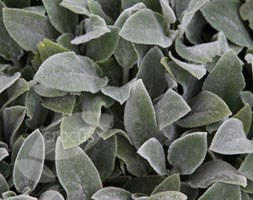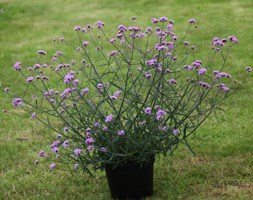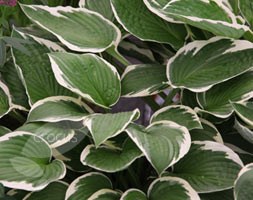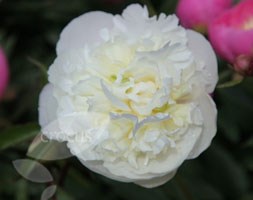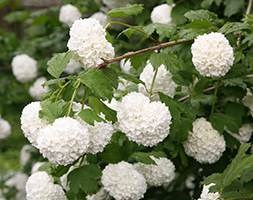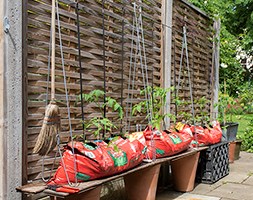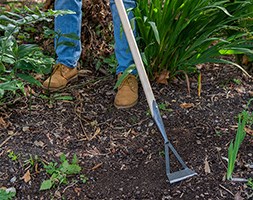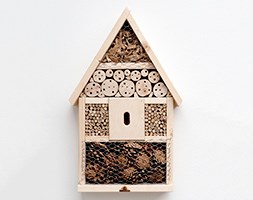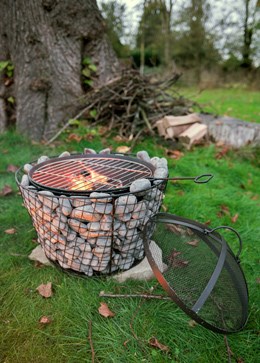Price reductions at Crocus
by Sarah - January 6th, 2016.Filed under: Crocus, Price Reductions.
Crocus has cut the price of these products
Stachys byzantina ‘Silver Carpet’ (lamb’s ears) was £5.99 now £4.49
Position: full sun Soil: well-drained, moderately fertile soil Rate of Growth: average Other features: silvery white leaves Hardiness: fully hardy Rosettes of silver, greyish white leaves provide an attractive, weed suppressing carpet for much of the year. This variety of ‘Lamb’s Ears’ rarely flowers and is an excellent, drought-tolerant groundcover or edging plant for a well-drained site in full sun. The foliage is a more intense shade of silver than flowering varieties of the plant. Garden care: Pick off and destroy any foliage that becomes infected by powdery mildew and treat the remaining leaves with fungicide. Lift and divide large clumps in early spring.
Verbena bonariensis ‘Lollipop’ (PBR) (verbena) was £6.99 now £5.99
Buy 1 Verbena ‘Lollipop’ for £6.99, or buy 3 for £15.97 and save £5 Position: full sun Soil: moderately fertile, moist, well-drained soil Flowering period: June to September Hardiness: borderline hardy (will need protection in winter in colder areas) One of the reasons Verbena bonariensis is such a superb plant in the border is that it gives airiness and floatiness to the border, creating a new level of planting within the border and a great visual impact. Verbena bonariensis is one of the best cottage garden plants and this stylish perennial has been enjoying a resurgence of interest in recent years. Well, now there is a new kid on the block – Verbena bonariensis ‘Lollipop’ (PBR). ‘Lollipop’ is a lower growing selection of bonariensis that is ideal for planting at the front of borders and above low-growing plants. Planted with plants such as Alchemilla mollis (lady’s mantle), the incredible clusters of lavender flowers will give the same eye-catching tiered effect that you get with bonariensis in the middle of the border. It also has the same excellent flowering period (June to September). This new plant is propagated by cuttings commercially under licence from the plant breeder, so it is very uniform and identical to the parent plant. It grows best in moist or well-drained soil and it prefers a sunny spot in the garden. It grows to 2ft tall with a 2ft spread, whereas standard Verbena bonariensis grows to 6ft tall. ‘Lollipop’ is as hardy and easy to grow as bonariensis and it will become a popular plant in the garden.
Hosta ‘Francee’ (fortunei) (plantain lily) was £9.99 now £7.99
Position: partial or full shade Soil: fertile, moist, well-drained soil Rate of growth: fast-growing Flowering period: July and August Hardiness: fully hardy A smart hosta, with heart-shaped, olive-green, puckered leaves beautifully offse t by neat white margins. Spikes of trumpet-shaped, lavender-blue flowers appear in July and August and, provided they are protected from slug and snail damage, the leaves retain their freshness until the end of September. This pretty plai ntain makes a statement on its own in a large container, or try it as a bright f ull stop in a shady area under deciduous trees. Garden care: You’ll get thicker, lusher leaves if you give your hostas a really good feed. An annual mulch in spring or autumn will help to keep the weeds down and is an easy way to improve soil and boost nutrient levels. Add a generous mulch of about 5-10cm (2-4in) deep of garden compost or leaf mould around the plant. Spraying the leaves regularly with a high nitrogen fertiliser during the growing season will also help to boost leaf size. Slugs and snails love hostas, so you will need to protect against them. Use an organic nematode treatment in early spring to ward off slugs. Or simply sti ck to a container. Water your hostas well as soon as you plant them and from then on water regularly during their first growing season. Give them a water about once or twice a week around the base of the plant, avoiding the leaves. Little and often can be disatrous as it encourages the plant to produce roots closer to the surface in a desperate quest for moisture.
Paeonia lactiflora ‘Duchesse de Nemours’ (paeony / peony) was £14.99 now £10.49
Position: full sun or partial shade Soil: fertile, moisture-retentive yet well-drained Rate of growth: average Flowering period: June to July Hardiness: fully hardy Prized for their blowsy, glamorous blooms and glossy, deeply cut foliage, peonies are held in deep affection by many gardeners, despite their short flowering season and vulnerability to peony wilt in damp weather. It’s easy to see why. From the promise of early spring, when their red, mottled shoots push through bare earth and the handsome foliage unfurls from spherical red buds, to early summer, when the huge flowers burst open, peonies exert a fascination that few can resist. ‘Duchesse de Nemours’ has huge, bowl-shaped pure white, fragrant, double flowers, flushed green in bud, from early to midsummer. This classic, double- flowered peony from the mid nineteenth century is a favourite of the cut-flower trade. It will thrive in full sun or partial shade. Fill the bare ground around the peony before the leaves appear with spring bulbs to prolong the season of interest. Garden care: Deadhead after flowering. In early spring apply a top dressing of a balanced slow release fertiliser around the base of the plant and mulch with well-rotted compost or manure. If the plant shows signs of collapse or the leaves become spotty, this may be a symptom of peony botrytis. Remove affected leaves immediately. In the autumn, cut off all the foliage and dispose of it to prevent reinfection the following spring.
Viburnum opulus ‘Roseum’ (snowball tree ( syn. Sterile )) was £17.99 now £14.39
Position: full sun or partial shade Soil: moderately fertile, moist, well-drained soil Rate of growth: fast-growing Flowering period: May and June Flower colour: white or green-tinted white flowers Hardiness: fully hardy In May and June the branches of this vigorous deciduous shrub are smothered with large, snowball-like clusters of white or green-tinted white flowers – which sometimes age to pink. With maple-like, fresh green leaves that become purple-tinted in autumn it’s an excellent ornamental plant for a sunny shrub or mixed border with fertile, moist, well-drained soil. Garden care: After flowering prune established specimens, removing up to one in five of the oldest and weakest branches to the base. Apply a generous 5-7cm (2-3in) mulch of well-rotted garden compost or manure around the base of the plant.
The grow-bag frame was £19.99 now £16.99
Made in the UK from recycled steel, this clever new frame is easy to assemble using a unique, clip fixing system. The plastic straps provide a strong vertical plant support system, which is ideal for growing taller plants like tomatoes and runner beans. The lower steel cross bar draws the bag upwards, making a deeper bed for roots to develop and it also creates voids that make it easier to apply water and fertiliser. Once erected it is quite sturdy and can even be gently moved around. After use it can be dismantled and folded flat for easy storage until next time. Measurements: Height 120cm Depth 30cm Width 90cm
De Wit dutch hoe was £29.99 now £22.99
An original Dutch push hoe. Instead of hoeing you can push the hoe underneath the surface to cut the roots of the weeds. The extra long handle is made from European ash. De Wit is an FSC registered company who guarantees that all the handles are made from wood out of FSC controlled forestry. Size – 1600 x 120 x 140mm The Dutch are rightly regarded as makers of the finest gardening tools. De Wit have been around longer than anyone. They started in 1898 and the 4th generation of De Wits are now in charge of the business; one is a trained wood turner, the other trained as a blacksmith. De Wit forge their tools from carbon steel in the traditional way. Carbon Steel is naturally tougher than stainless steel and is not prone to metal fatigue. De Wit also burnish their steel. This not only helps to protect it for longer but gives it a patina that blackens it – just like traditional English tools from the Edwardian era. All De Wit tools have turned hardwood handles of oiled Ash. Ash is not only very strong but resists shock better than woods like oak or beech, which is why it was traditionally used for Axe handles. The result is a beautiful tool to hold in the hand but rugged and durable. They feel so natural to use that they are like an extension of the person that uses them. These tools will give you a lifetime of use, until you hand them on.
Insect mansion was £49.99 now £44.99
This insect hotel not only looks at home in any garden but also provides an ideal habitat for lots of useful insects that are beneficial for the plants in your garden. Its provides a place for nesting in the summer and a suitable winter habitat for colder months. Each nesting room is ideal for different beneficial garden insects: Ladybirds – The top and bottom rooms are ideal for them as they prefer nesting in dense materials and they will use this as a hiding place at night. They are great at regulating unwanted pests such as greenfly and blackfly. Mason bees – The room with the hollowed out wood provides ideal breeding tubes. They will shut themselves away in the winter and come out in the spring ready to help pollenate your plants. Digger wasps – The two rooms with the smaller bamboo tubes are ideal for digger wasps who are extremely useful in the battle against greenfly, blackfly and leaf beetle larve. Wild bees – They also make use of the rooms with the smaller bamboo tubes as a suitable nesting space and can be out ready for polinating in early spring or summer. Butterflies – Species such as Brimstone, Peacock, Small tortoise-shell and Admiral use the middle room as a winter habitat and shelter during periods of bad weather ready for pollinating in spring/summer. Green lacewing – The bottom room is perfect for them as they love loosly stacked natural materials to take shelter in. THese lacewing feed on aphids, thrips and mealy bugs as well as honeydew and nectar from herbs. Measurements: Height: 56cm Width: 29cm Depth: 10cm
Pebble firepit was £59.99 now £49.99
This mesh surround fire pit will create a stunning focal point on cool summer evenings. Create a beautiful display by interchanging the pebbles to suit your garden style or even the season. Please note the pebbles are not supplied with the fire pit. This firepit does come with the grill and lid. Measurements: Outside diameter: 44cm Height: 43cm







